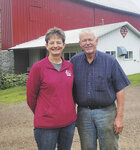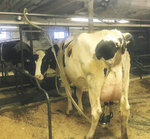

ALMA CENTER, Wis. — Richard and Sara Larson’s 42-year dairy career had its share of challenges, but also included many highlights.
“It’s been good to us,” Richard Larson said. “It’s been tougher at times, but it’s been alright.”
Richard and Sara sold their 26-cow dairy herd in April to retire from milking on their farm near Alma Center.
Richard purchased the farm on a land contract July 8, 1981. The 16-year-old had just finished his sophomore year of high school. He had been renting the land since he was 14 years old, with his father co-signing a crop loan. When the owner was ready to retire, they made a deal with Richard to purchase the farm.
The interest rate on the land contract was 12.75% and personal property was charged at 19% interest. Richard purchased 24 calves in the fall of 1981, raised them, bred them and then sold all but seven as springing heifers in 1983. He bought another 30 milking cows when he was 18.
“At the beginning, I was considered high risk so in my first year of milking cows they took 45% of my milk check,” Richard said.
“The land contract payment was $13,400 and some odd dollars and in the first year, the principal was 21 bucks. That’s the honest-to-goodness truth.”
Richard milked his 37 cows with bucket milkers and a step saver at first and did not have a barn cleaner or silo unloader. He did have support from his brother, Jon, eight years his elder, who was established with a dairy on the farm next door. He and Richard shared his equipment.
In Richard’s first year shipping milk in 1983, he received a base pay of $14.50 per hundredweight. With the fat differential, Richard figures he received close to $16 cwt.
“That was 42 years ago,” Richard said. “When we sold our cows, our last milk check was $16.87(cwt).”
Richard and Sara were married in 1995 and had their only child, Bailey, in 1997. The milking herd had grown to about 50 cows. They were milking at Jon’s farm and using Richard’s facilities for youngstock. Jon also milked his own herd so altogether they were milking close to 100 cows.
Jon was diagnosed with cancer and passed away in 2011. At his passing, he and Richard had farmed together for 29 years.
In 2000, when Jon began traveling for treatments, Richard and Sara sold their cows so they could take care of Jon’s herd. When his treatments ended and Jon returned, he resumed milking and Richard and Sara decided to remodel the barn at their farm and milk cows again, but on a smaller scale.
They calved in heifers and purchased a few more cows. Their barn held 26 milk cows and from then on, the milking string never exceeded that number. They kept all their youngstock and raised heifers for replacements and steers for a cash crop. They also sold hay and corn as cash crops.
Sara said diversity kept them profitable.
“That’s how we made it over the years,” Sara said. “We had multiple things, and something was usually high, whether it was hay or corn or beans or steers or cull cows.”
The couple also credits their dairy herd for their success. In 1985, Richard was one of the first herds in Jackson County to implement a mating program through what is now ABS Global Inc. They averaged between 75-85 pounds of milk per cow per day throughout their career. Their feeding program consisted of a silo of haylage and another of corn silage. In later years Richard added steam-flaked corn to the ration, which he said yielded good results.
The Larsons shipped their milk to Associated Milk Producers Inc. throughout their career and received many quality awards. Their best tank somatic cell count was 20,000.
“I’ll never forget that,” Richard said. “The one year we averaged just over 100 (SCC).”
The couple had one hired man to help with crops but did all the milking themselves. They were also diligent about managing the time the cows spent in the barn or on pasture.
“If it was too hot they were in the barn; if it was too wet they were in the barn,” Sara said. “We spent a lot of time just coordinating them. Everything (revolved) around the cows.”
Richard agreed.
“You don’t realize how much you think about them until they’re gone,” Richard said.
Richard and Sara watched the industry change in 42 years of dairying. Richard said the biggest change is how farming has evolved to require a business mind.
“It was always work but it’s just as much thinking now,” Richard said. “You’ve got to be so careful. One mistake, whether you can prevent it or not, can cost you thousands.”
The couple plans to enjoy their retirement from milking by raising some youngstock and continuing to crop. Sara also purchased a couple of goats to keep her company.
Comments
No comments on this item Please log in to comment by clicking here